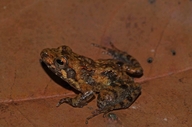|
Description
A small frog, 25-30 mm, in some populations (e.g., Andasibe) smaller than in others (e.g., Nosy Mangabe). Tibiotarsal articulation reaches nostrils or tip of snout. Hand without webbbing, foot with rudimentary webbing. Inner metatarsal tubercle relatively small and pigmented. Dorsal skin granular without ridges. Colouration very variable, with a predominance of dark brown. Upper lip without continuous white band. Males with distinct femoral glands and blackish paired subgular vocal sacs.
Similar species: All other species of the subgenus Gephyromantis. G. boulengeri is recognized by lacking any dorsal ridges and instead having a rather granular skin.
Distribution and Habitat
Country distribution from AmphibiaWeb's database: Madagascar
Ambatolahy forest, Ambatovaky, An’Ala, Andasibe, Fenoarivo, Nosy Boraha, Nosy Mangabe, near Ifanadiana. It occurs between sea level and 1,200m asl in rainforest, degraded forest, and invasive eucalyptus forest in the rainforest belt (Vences and Glaw 2008).
Life History, Abundance, Activity, and Special Behaviors
Habits: Males call during the day from the forest floor, or from perches up to 100 cm above the ground. They can be heard in dense rainforest but also in secondary vegetation, as long as dense and moist vegetation covers the ground. Specimens do not form choruses and are spaced throughout the forest, at positions independent from free water.
Calls: A loud and fast series of 7-20 melodious notes, emitted as a sudden burst. A typical sound heard during the day throughout rainforests in eastern Madagascar, for example around Andasibe and on Nosy Mangabe.
Trends and Threats
Its forest habitat is declining due to subsistence agriculture, timber extraction, charcoal manufacture, and livestock grazing and expanding human settlements. It occurs in several protected areas throughout the eastern rainforest belt (Vences and Glaw 2008). Possible reasons for amphibian decline General habitat alteration and loss
Habitat modification from deforestation, or logging related activities
Intensified agriculture or grazing
Habitat fragmentation
Comments
Taken with permission from Glaw and Vences (2007).
References
Glaw, F., and Vences, M. (2007). Field Guide to the Amphibians and Reptiles of Madagascar. Third Edition. Vences and Glaw Verlag, Köln.
Vences, M. and Glaw, F. (2008). Gephyromantis boulengeri. In: IUCN 2008. 2008 IUCN Red List of Threatened Species. www.iucnredlist.org. Downloaded on 14 April 2009.
Originally submitted by: Miguel Vences and Frank Glaw (first posted 2000-11-27)
Edited by: Henry Zhu (2009-05-06)Species Account Citation: AmphibiaWeb 2009 Gephyromantis boulengeri <https://amphibiaweb.org/species/4586> University of California, Berkeley, CA, USA. Accessed Jun 1, 2025.
Feedback or comments about this page.
Citation: AmphibiaWeb. 2025. <https://amphibiaweb.org> University of California, Berkeley, CA, USA. Accessed 1 Jun 2025.
AmphibiaWeb's policy on data use.
|
